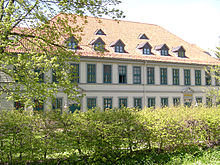Old coin of Clausthal

The Alte Münze zu Clausthal is a building in Clausthal-Zellerfeld , Clausthal district. It was built in 1726 and served as a mint from then until 1849 . In the same year the mint was relocated to Hanover . Therefore it became the headquarters of the Oberharzer Berg- und Hüttenwerke . In 1950 the old mint was converted into a student residence.
Building history
The baroque building was completed in May 1726 and was Clausthal's third mint building. Originally, coins were minted in Clausthal from 1617. Duke Christian von Celle set up a hammer coin in Claushoff, an older mansion, in 1617. The second coin from 1674 was equipped with a push mechanism and a horse-powered drafting mechanism and was thus much more modern than the first coin. After the great city fire in 1725, in which the second coin was destroyed down to the foundation, the third coin was built on the existing foundation. The characteristics of the second coin were retained, but there was a separation into living and business areas.
Building use
All Clausthaler mint buildings had a double function as residential building and mint operation. The later inventor of the wire rope , Julius Albert , was responsible for the administration of the mint as Hanoverian miner from 1821. After the merging of the coinage in Hanover and the dissolution of the Clausthaler Münze in 1848, the house served essentially as an administration building for a good hundred years. The different users included the Oberbergamt and the Bergakademie .
In 1950, the Bergakademie acquired the property and converted the building into a student dormitory, dorm 1. Above all, this conversion and the extensive renovation carried out in 1988/89 by the owner, the Studentenwerk Clausthal (since 2007: Studentenwerk Braunschweig, renamed Studentenwerk OstNiedersachsen in 2011 ), led to serious changes in the floor plan structure. However, the listed facade was preserved and the originally clearly structured roof landscape was approximately restored. A cafeteria of the student union was set up on the ground floor until the summer semester of 2002. During another renovation in 2006/07, single apartments were created on the ground floor.
Two cities - two coins
The mining towns of Clausthal and Zellerfeld belonged to different duchies when they were founded in the 16th century. They each had their own administration and mints. Since the beginning of the 17th century, the sovereigns had silver coins in the Harz Mountains. All stages of production were concentrated in the Harz, from mining the ores containing silver to processing and smelting to minting coins.
Duke Heinrich Julius established the Zellerfeld Mint in 1601 . The new mint, today's arts and crafts yard, was created in 1673/74 after the great fire in Zellerfeld. Both mints minted exploitation thalers, medals and, above all, local currency. When the Electorate of Hanover received the mining towns of Zellerfeld, Wildemann , Grund and Lautenthal from the Duke of Braunschweig-Wolfenbüttel in 1789 , the entire mining administration was moved to Clausthal and the two Harz mints were also united there. In addition, there was only the mint in Hanover in the entire Electorate . This increased Clausthal's position in the region enormously.
Individual evidence
- ↑ Studentenwerk wants to break even: "Münze" stays closed. Goslarsche Zeitung , archived from the original on October 30, 2007 ; Retrieved April 25, 2009 .
Web links
- History of the "Old Mint". In: Clausthal Student Union. Archived from the original on October 30, 2007 ; Retrieved April 24, 2009 .
- Current page of the Studentenwerk OstNiedersachsen about the "Old Mint"
Coordinates: 51 ° 48 ′ 11 ″ N , 10 ° 19 ′ 54 ″ E